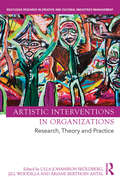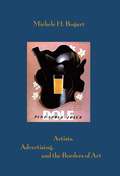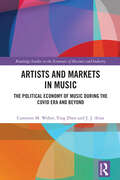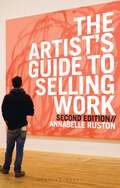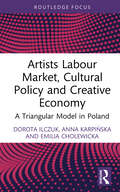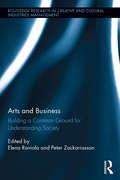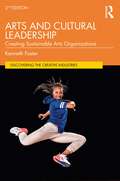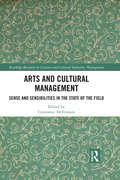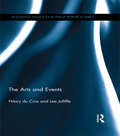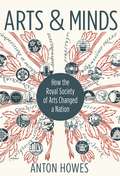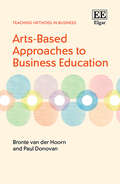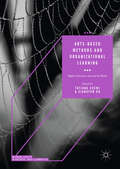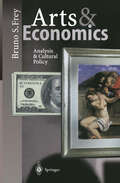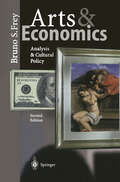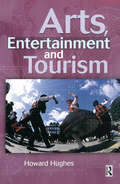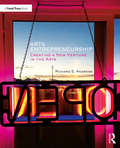- Table View
- List View
Artistic Interventions in Organizations: Research, Theory and Practice (Routledge Research in the Creative and Cultural Industries)
by Ariane Berthoin Antal Ulla Johansson Sköldberg Jill WoodillaArtistic intervention, where the world of the arts is brought into organizations, has increasingly become a research field in itself with strong links to both creativity and innovation. Opportunities for the arts to interact with public and private organizations occur worldwide, but during the last decade artistic interventions have received growing attention in both practice and research. This book is the first comprehensive attempt to map the development of the field and provides an international overview of the area of artistic interventions and their impact on organizations from different perspectives, ranging from strategic management to organizational development, innovation and organizational learning. Featuring chapters from prominent and emerging scholars, including Nancy J. Adler, Barbara Czarniawska, Lotte Darsø and Alexander Styhre, it places artistic interventions within an international context. The book also offers readers the opportunity to learn from experiences in a varied range of organisations, including newspapers, manufacturing, government, schools, and covers many art-forms, such as music, contemporary dance, painting, photography, and theatre. Using extensive empirical examples, this book is vital reading for researchers and scholars of creativity and cultural industries, as well as innovation, creative entrepreneurship, organizational studies and management.
Artistic Interventions in Organizations: Research, Theory and Practice (Routledge Research in the Creative and Cultural Industries)
by Ariane Berthoin Antal Ulla Johansson Sköldberg Jill WoodillaArtistic intervention, where the world of the arts is brought into organizations, has increasingly become a research field in itself with strong links to both creativity and innovation. Opportunities for the arts to interact with public and private organizations occur worldwide, but during the last decade artistic interventions have received growing attention in both practice and research. This book is the first comprehensive attempt to map the development of the field and provides an international overview of the area of artistic interventions and their impact on organizations from different perspectives, ranging from strategic management to organizational development, innovation and organizational learning. Featuring chapters from prominent and emerging scholars, including Nancy J. Adler, Barbara Czarniawska, Lotte Darsø and Alexander Styhre, it places artistic interventions within an international context. The book also offers readers the opportunity to learn from experiences in a varied range of organisations, including newspapers, manufacturing, government, schools, and covers many art-forms, such as music, contemporary dance, painting, photography, and theatre. Using extensive empirical examples, this book is vital reading for researchers and scholars of creativity and cultural industries, as well as innovation, creative entrepreneurship, organizational studies and management.
Artists, Advertising, and the Borders of Art
by Michele H. BogartNorman Rockwell and Andy Warhol, J. C. Leyendecker and Georgia O'Keeffe, the Metropolitan Museum of Art and Pepsi-Cola, the avant garde and the Famous Artists Schools, Inc.: these are some of the unexpected pairings encountered in Artists, Advertising, and the Borders of Art. In the first interdisciplinary study of the imagery and practices of commercial artists, Michele H. Bogart explores, in unprecedented detail, the world of commercial art—its illustrators, publishers, art directors, photographers, and painters. She maps out the long, permeable border between art and commerce and expands our picture of artistic culture in the twentieth century. From the turn of the century through the 1950s, the explosive growth of popular magazines and national advertising offered artists new sources of income and new opportunities for reaching huge audiences. Bogart shows how, at the same time, this change in the marketplace also forced a rethinking of the purpose of the artistic enterprise itself. She examines how illustrators such as Howard Pyle, Charles Dana Gibson, and Norman Rockwell claimed their identities as artists within a market-oriented framework. She looks at billboard production and the growing schism between "art" posters and billboard advertisements; at the new roles of the art director; at the emergence of photography as the dominant advertising medium; and at the success of painters in producing "fine art" for advertising during the 1930s and 1940s.
Artists and Markets in Music: The Political Economy of Music During the Covid Era and Beyond (Routledge Studies in the Economics of Business and Industry)
by Cameron M. Weber Ying Zhen J.J. AriasThis monograph is an innovative examination of the political economy of music. It integrates original economic theories and empirical research to shed light on the economic and social forces shaping music and society today. Interactive relationships, such as the importance of entrepreneurship, serendipity and authenticity, will be explored in artist subjective determinations of success. In particular, this book deeply explores the mental health of musicians and "creative destruction" during the covid era, copyrights in music markets and an evaluation of the importance of entrepreneurship and brand marketing in the life of musical artists. The monograph contributes empirical research to underexplored areas in the cultural economics of music, such as the proposed musical production function by Samuel Cameron (Routledge 2015) and the concept of distinction in cultural production by Pierre Bourdieu (Routledge 1984, 2010) as uniquely applied with examples from the covid era. Readers will benefit from this easy-to-understand interdisciplinary exploration of the music industry with a focus on the United States and the political economy of music during the covid era. Most cultural economics is focused on Europe and Asia, so this emphasis on the United States will be of interest. This book will be a beneficial reference work for researchers and will find an audience among music professionals and artists. Academics and non-academics, experts and novices interested in music and political economy will also find value in Artists and Markets in Music.
Artists and Markets in Music: The Political Economy of Music During the Covid Era and Beyond (Routledge Studies in the Economics of Business and Industry)
by Cameron M. Weber Ying Zhen J.J. AriasThis monograph is an innovative examination of the political economy of music. It integrates original economic theories and empirical research to shed light on the economic and social forces shaping music and society today. Interactive relationships, such as the importance of entrepreneurship, serendipity and authenticity, will be explored in artist subjective determinations of success. In particular, this book deeply explores the mental health of musicians and "creative destruction" during the covid era, copyrights in music markets and an evaluation of the importance of entrepreneurship and brand marketing in the life of musical artists. The monograph contributes empirical research to underexplored areas in the cultural economics of music, such as the proposed musical production function by Samuel Cameron (Routledge 2015) and the concept of distinction in cultural production by Pierre Bourdieu (Routledge 1984, 2010) as uniquely applied with examples from the covid era. Readers will benefit from this easy-to-understand interdisciplinary exploration of the music industry with a focus on the United States and the political economy of music during the covid era. Most cultural economics is focused on Europe and Asia, so this emphasis on the United States will be of interest. This book will be a beneficial reference work for researchers and will find an audience among music professionals and artists. Academics and non-academics, experts and novices interested in music and political economy will also find value in Artists and Markets in Music.
The Artist's Guide to Selling Work
by Annabelle RustonThis best-selling guide provides all the advice artists and craftspeople need to sell their work in today's competitive market. This fantastic new edition has been updated with essential advice on how to make full use of digital opportunities for selling your work, such as social networking and e-marketing. It contains information and suggestions about:Selecting and approaching galleries Pricing and paymentsRoyalty rates and financial managementSample contracts and other legal considerationsCreating a website and maximising hitsMastering social media to increase your visibilityManaging sales via online stores such as Etsy, Folksy or ebayPrinting your own reproductions and marketing themWith a foreword by Mary Ann Rogers, one of Britain's most acclaimed watercolour painters and awarded 'Best Selling Published Artist' by the Fine Art Trade Guild in 2009.
Artists Labour Market, Cultural Policy and Creative Economy: A Triangular Model in Poland (Routledge Focus on Economics and Finance)
by Dorota Ilczuk Anna Karpińska Emilia CholewickaFocusing on artists and creators, this shortform book analyses the labour market in the creative economy in the context of cultural policies.Based on a series of studies involving Polish artists spanning 10 years, the book identifies the key factors needed to understand contemporary labour markets in the creative and cultural sectors worldwide. The authors integrate artists’ perspectives to present truly rounded evidence, shedding light on the applicational perspective of the research findings.Illuminating the socioeconomic status of artists in Poland, this book is essential reading for researchers interested in cultural policy and the creative economy, as well as work and labour studies more broadly. It will also be of interest to practitioners in the creative and cultural industries.
Artists Labour Market, Cultural Policy and Creative Economy: A Triangular Model in Poland (Routledge Focus on Economics and Finance)
by Dorota Ilczuk Anna Karpińska Emilia CholewickaFocusing on artists and creators, this shortform book analyses the labour market in the creative economy in the context of cultural policies.Based on a series of studies involving Polish artists spanning 10 years, the book identifies the key factors needed to understand contemporary labour markets in the creative and cultural sectors worldwide. The authors integrate artists’ perspectives to present truly rounded evidence, shedding light on the applicational perspective of the research findings.Illuminating the socioeconomic status of artists in Poland, this book is essential reading for researchers interested in cultural policy and the creative economy, as well as work and labour studies more broadly. It will also be of interest to practitioners in the creative and cultural industries.
Arts and Business: Building a Common Ground for Understanding Society (Routledge Research in the Creative and Cultural Industries)
by Elena Raviola Peter ZackariassonArts and Business aims at bringing arts and business scholars together in a dialogue about a number of key topics that today form different understandings in the two disciplines. Arts and business are, many times, positioned as opposites. Where one is providing symbolic and aesthetic immersion, the other is creating goods for a market and markets for a good. They often deal and struggle with the same issues, framing it differently and finding different solutions. This book has the potential of offering both critical theoretical and empirical understanding of these subjects and guiding further exploration and research into this field. Although this dichotomy has a well-documented existence, it is reconstructed through the writing-out of business in art and vice versa. This edited volume distinguishes itself from other writings aimed at closing the gap between art and business, as it does not have a firm standpoint in one of these fields, but treating them as symmetrical and equal. The belief that by giving art and business an equal weight, the editors also create the opportunity to communicate to a wider audience and construct a path forward for art and business to coexist.
Arts and Business: Building a Common Ground for Understanding Society (Routledge Research in the Creative and Cultural Industries)
by Elena Raviola Peter ZackariassonArts and Business aims at bringing arts and business scholars together in a dialogue about a number of key topics that today form different understandings in the two disciplines. Arts and business are, many times, positioned as opposites. Where one is providing symbolic and aesthetic immersion, the other is creating goods for a market and markets for a good. They often deal and struggle with the same issues, framing it differently and finding different solutions. This book has the potential of offering both critical theoretical and empirical understanding of these subjects and guiding further exploration and research into this field. Although this dichotomy has a well-documented existence, it is reconstructed through the writing-out of business in art and vice versa. This edited volume distinguishes itself from other writings aimed at closing the gap between art and business, as it does not have a firm standpoint in one of these fields, but treating them as symmetrical and equal. The belief that by giving art and business an equal weight, the editors also create the opportunity to communicate to a wider audience and construct a path forward for art and business to coexist.
Arts and Cultural Leadership: Creating Sustainable Arts Organizations (Discovering the Creative Industries)
by Kenneth FosterThis textbook provides an expert overview of the challenge of arts and cultural leadership in the contemporary world. Grounded in theories of sustainability and with a renewed global focus for this second edition, the author’s insights from contemporary arts organizations facilitate meaningful student comprehension. Drawing on the work of practitioners and theorists in the fields of philosophy, biology, and ecology as well as the arts, Foster proposes a rethinking of organizational design, strategy, and structure that is based on ecological concepts and the creative process that is intrinsic to the arts rather than the conventional business model that currently prevails, particularly in western arts and culture organizations. He contests conventional thinking about arts administration and management and urges arts leaders to foreground innovation as they reimagine their organizations for a world unlike any other. New sections include an enhanced theoretical discussion as well as new material on business models, strategy, and organizational design and practice. Applicable to any arts organization, the entrepreneurial focus is especially relevant in the aftermath of the global pandemic, the ongoing climate crisis, and the quest for democracy and social justice. This updated edition will be a valuable resource both for present-day arts and cultural leaders who are working to adapt to the current environment as well as students and future leaders who aspire to make change in the world through arts and cultural leadership.
Arts and Cultural Leadership: Creating Sustainable Arts Organizations (Discovering the Creative Industries)
by Kenneth FosterThis textbook provides an expert overview of the challenge of arts and cultural leadership in the contemporary world. Grounded in theories of sustainability and with a renewed global focus for this second edition, the author’s insights from contemporary arts organizations facilitate meaningful student comprehension. Drawing on the work of practitioners and theorists in the fields of philosophy, biology, and ecology as well as the arts, Foster proposes a rethinking of organizational design, strategy, and structure that is based on ecological concepts and the creative process that is intrinsic to the arts rather than the conventional business model that currently prevails, particularly in western arts and culture organizations. He contests conventional thinking about arts administration and management and urges arts leaders to foreground innovation as they reimagine their organizations for a world unlike any other. New sections include an enhanced theoretical discussion as well as new material on business models, strategy, and organizational design and practice. Applicable to any arts organization, the entrepreneurial focus is especially relevant in the aftermath of the global pandemic, the ongoing climate crisis, and the quest for democracy and social justice. This updated edition will be a valuable resource both for present-day arts and cultural leaders who are working to adapt to the current environment as well as students and future leaders who aspire to make change in the world through arts and cultural leadership.
Arts and Cultural Management: Sense and Sensibilities in the State of the Field (Routledge Research in the Creative and Cultural Industries)
by Constance DeVereauxArts and Cultural Management: Sense and Sensibilities in the State of the Field opens a conversation that is much needed for anyone identifying arts management or cultural management as primary areas of research, teaching, or practice. In the evolution of any field arises the need for scrutiny, reflection, and critique, as well as to display the advancements and diversity in approaches and thinking that contribute to a discipline’s forward progression. While no one volume could encompass all that a discipline is or should be, a representational snapshot serves as a valuable benchmark. This book is addressed to those who operate as researchers, scholars, and practitioners of arts and cultural management. Driven by concerns about quality of life, globalization, development of economies, education of youth, the increasing mobility of cultural groups, and many other significant issues of the twenty-first century, governments and individuals have increasingly turned to arts and culture as means of mitigating or resolving tough policy issues. For their growth, arts and culture sectors depend on people in positions of leadership and management who play a significant role in the creation, production, exhibition, dissemination, interpretation, and evaluation of arts and culture experiences for publics and policies. Less than a century old as a formal field of inquiry, however, arts and cultural management has been in flux since its inception. What is arts and cultural management? remains an open question. A comprehensive literature on the discipline, as an object of study, is still developing. This State of the Discipline offers a benchmark for those interested in the evolution and development of arts and cultural management as a branch of knowledge alongside more established disciplines of research and scholarship.
Arts and Cultural Management: Sense and Sensibilities in the State of the Field (Routledge Research in the Creative and Cultural Industries)
by Constance DeVereauxArts and Cultural Management: Sense and Sensibilities in the State of the Field opens a conversation that is much needed for anyone identifying arts management or cultural management as primary areas of research, teaching, or practice. In the evolution of any field arises the need for scrutiny, reflection, and critique, as well as to display the advancements and diversity in approaches and thinking that contribute to a discipline’s forward progression. While no one volume could encompass all that a discipline is or should be, a representational snapshot serves as a valuable benchmark. This book is addressed to those who operate as researchers, scholars, and practitioners of arts and cultural management. Driven by concerns about quality of life, globalization, development of economies, education of youth, the increasing mobility of cultural groups, and many other significant issues of the twenty-first century, governments and individuals have increasingly turned to arts and culture as means of mitigating or resolving tough policy issues. For their growth, arts and culture sectors depend on people in positions of leadership and management who play a significant role in the creation, production, exhibition, dissemination, interpretation, and evaluation of arts and culture experiences for publics and policies. Less than a century old as a formal field of inquiry, however, arts and cultural management has been in flux since its inception. What is arts and cultural management? remains an open question. A comprehensive literature on the discipline, as an object of study, is still developing. This State of the Discipline offers a benchmark for those interested in the evolution and development of arts and cultural management as a branch of knowledge alongside more established disciplines of research and scholarship.
The Arts and Events (Routledge Advances in Event Research Series)
by Hilary Du Cros Lee JolliffeCultural heritage and contemporary arts benefit from being showcased in events. Arts-related events are each unique in reflecting local culture; they may be therefore spontaneous (street art and so on) or planned (i.e. studio tours or arts festivals). The Arts and Events explores the nature and complexity of managing arts events and fills a significant gap in the available literature. It investigates the history, development and management of arts events to offer much needed insight into creating economic, social and cultural capital. It therefore contributes to a greater understanding of how arts events can create a beneficial experience for the individual and the community as well as their future sustainable development. The title explores a broad range of events from around the globe including: inspirational events for building creative (social, cultural and human) capital; affirming events for encouraging links to cultural identity or heritage; pleasurable events that offer enjoyable recreational, leisure and touristic experiences; enriching events that create opportunities for personal growth and/or to sell products or experiences, and finally, celebratory events that enhance cultural diversity. This significant volume is a valuable source for researchers, policy-makers and managers of arts events around the globe.
The Arts and Events (Routledge Advances in Event Research Series)
by Hilary Du Cros Lee JolliffeCultural heritage and contemporary arts benefit from being showcased in events. Arts-related events are each unique in reflecting local culture; they may be therefore spontaneous (street art and so on) or planned (i.e. studio tours or arts festivals). The Arts and Events explores the nature and complexity of managing arts events and fills a significant gap in the available literature. It investigates the history, development and management of arts events to offer much needed insight into creating economic, social and cultural capital. It therefore contributes to a greater understanding of how arts events can create a beneficial experience for the individual and the community as well as their future sustainable development. The title explores a broad range of events from around the globe including: inspirational events for building creative (social, cultural and human) capital; affirming events for encouraging links to cultural identity or heritage; pleasurable events that offer enjoyable recreational, leisure and touristic experiences; enriching events that create opportunities for personal growth and/or to sell products or experiences, and finally, celebratory events that enhance cultural diversity. This significant volume is a valuable source for researchers, policy-makers and managers of arts events around the globe.
Arts and Minds: How the Royal Society of Arts Changed a Nation
by Anton HowesA major new history of the extraordinary society that has touched all aspects of British lifeFrom its beginnings in a coffee house in the mid-eighteenth century, the Royal Society for the Encouragement of Arts, Manufactures and Commerce has tried to improve British life in every way imaginable. It has sought to influence how Britons work, how they are educated, the music they listen to, the food they eat, the items in their homes, and even how they remember their own history. Arts and Minds is the remarkable story of an institution unlike any other—a society for the improvement of everything and anything.Drawing on exclusive access to a wealth of rare papers and artefacts from the Society's own archives, Anton Howes shows how this vibrant and singularly ambitious organisation has evolved and adapted, constantly having to reinvent itself to keep in step with changing times. The Society has served as a platform for Victorian utilitarian reformers, purchased and restored an entire village, encouraged the planting of more than sixty million trees, and sought technological alternatives to child labour. But this is more than just a story about unusual public initiatives. It is an engaging and authoritative history of almost three centuries of social reform and competing visions of a better world—the Society's members have been drawn from across the political spectrum, including Adam Smith, Edmund Burke, and Karl Marx.Informative and entertaining, Arts and Minds reveals how a society of public-spirited individuals tried to make their country a better place, and draws vital lessons from their triumphs and failures for all would-be reformers today.
Arts-Based Approaches to Business Education (Teaching Methods in Business series)
by Bronte van der Hoorn Paul DonovanArts-based Approaches to Business Education assists educators and facilitators in preparing students and professionals to be conscientious and skilled practitioners in the contemporary organization. With a strongly practical focus, the book outlines important questions to be asked before incorporating arts-based approaches into business education and shares step-by-step examples that can be used in the classroom. It presents a myriad of ways arts can be incorporated into business curriculum across diverse subject areas and demonstrates how arts-based approaches are an actionable ‘experiential learning’ tactic to respond to the calls for responsible management education and the critical management agenda.Included in the book are practical tips for implementation based on lessons learned from educators around the globe. It comprises scaffolds for using arts-based approaches, including a three-pillar framework for assessing the suitability of arts-based approaches in business education, five example classes for incorporating the arts in the business classroom and an annotated bibliography, with over 25 curated resources to support further exploration of arts-based approaches in business education.Part of our Teaching Methods in Business series, this book inspires educators and facilitators alike to consider new ways of engaging and preparing students for the challenges of the 21st century. Professors, business and management trainers and consultants, and organizational development and learning professionals will transform the experience of business education with the ideas presented herein.
Arts-based Methods and Organizational Learning: Higher Education Around the World (PDF)
by Tatiana Chemi Xiangyun DuThis thematic volume explores the relationship between the arts and learning in various educational contexts and across cultures, but with a focus on higher education and organizational learning. Arts-based interventions are at the heart of this volume, which addresses how they are conceived, designed, carried out, and assessed in different higher educational and cultural contexts. Readers will discover diverse perspectives of the contributing authors from across the world and from a variety of settings: formal education, informal learning for adults and organisational learning. A necessary introductory conceptualisation sets the stage for the discussion of the different cases, with chapters presented according to the art forms the address: performing arts, dance, music, language arts, visual arts, multi-arts and a conclusive chapter on future perspectives for arts-based educational approaches. Arts-based Methods and Organisational Learning: Higher Education Around the World will inspire and inform both scholars and practitioners who are dealing with the arts in education and organisations.
Arts & Economics: Analysis & Cultural Policy
by Bruno S. FreyUsing the economic point of view for an analysis of phenomena related to artistic activities, Arts & Economics not only challenges widely held popular views, but also offers an alternative perspective to sociological or art historic approaches. The wide range of subjects presented are of current interest and relevant for cultural policy. The issues discussed include: institutions from festivals to "superstar" museums, different means of supporting the arts, whether artistic creativity is undermined by public intervention, an investigation into art as an investment, the various approaches to valuing our cultural properties, and why direct voter participation in cultural policy is not antagonistic to artistic values.
Arts & Economics: Analysis & Cultural Policy
by Bruno S. FreyUsing the economic perspective, this exciting text offers an alternative view to sociological or art historic approaches to art. The issues discussed include: institutions from festivals to "superstar" museums, different means of supporting the arts, an investigation into art as an investment, and the various approaches applied when valuing our cultural properties. This text challenges widely held popular views and, once started, is difficult to put down.
Arts, Entertainment and Tourism
by Howard Hughes'Arts, Entertainment and Tourism' is a pioneering text that, by focusing on the consumer, investigates the relationship between these 3 industries and how this relationship can be developed to its best competitive advantage. Issue-led, this text draws on appropriate disciplines rather than using one single approach, to examine issues in arts and entertainment within the framework of cultural tourism.Written to meet the needs of students studying on management courses in the arts, tourism and leisure, 'Arts, Entertainment and Tourism':* Describes the general arts and tourism background* Identifies a framework for analysis that acknowledges differing levels of interest in the arts and entertainment* Discusses the arts and entertainment that feature (past and present) in tourism * Examines the reasons why the arts, entertainment and tourism have an interest in each other and how they go about developing the relationship* Examines the relationship: are there tourists in audiences and do the arts and entertainment attract tourists to a destination?* Evaluates the wider effects (good and bad) on both the arts and tourism* Discusses the direction of future developments by arts and tourism organizations and for future research
Arts, Entertainment and Tourism
by Howard Hughes'Arts, Entertainment and Tourism' is a pioneering text that, by focusing on the consumer, investigates the relationship between these 3 industries and how this relationship can be developed to its best competitive advantage. Issue-led, this text draws on appropriate disciplines rather than using one single approach, to examine issues in arts and entertainment within the framework of cultural tourism.Written to meet the needs of students studying on management courses in the arts, tourism and leisure, 'Arts, Entertainment and Tourism':* Describes the general arts and tourism background* Identifies a framework for analysis that acknowledges differing levels of interest in the arts and entertainment* Discusses the arts and entertainment that feature (past and present) in tourism * Examines the reasons why the arts, entertainment and tourism have an interest in each other and how they go about developing the relationship* Examines the relationship: are there tourists in audiences and do the arts and entertainment attract tourists to a destination?* Evaluates the wider effects (good and bad) on both the arts and tourism* Discusses the direction of future developments by arts and tourism organizations and for future research
Arts Entrepreneurship: Creating a New Venture in the Arts
by Richard AndrewsArts Entrepreneurship: Creating a New Venture in the Arts provides the essential tools, techniques, and concepts needed to invent, launch, and sustain a business in the creative sector. Building on the reader’s artistic talents and interests, the book provides a practical, action-oriented introduction to the business of art, focusing on product design, organizational planning and assessment, customer identification and marketing, fundraising, legal issues, money management, cultural policy, and career development. It also offers examples, exercises, and references that guide entrepreneurs through the key stages of concept creation, business development, and growth. Special attention is paid to topics such as cultural ventures seeking social impact, the emergence of creative placemaking, the opportunities afforded by novel corporate forms, and the role of contemporary technologies in marketing, fundraising, and operations. A hands-on guide to entrepreneurial success, this book is a valuable resource for students of Arts Entrepreneurship programs, courses, and workshops, as well as for early-stage business founders in the creative sector looking for guidance on how to create and sustain their own successful venture.
Arts Entrepreneurship: Creating a New Venture in the Arts
by Richard AndrewsArts Entrepreneurship: Creating a New Venture in the Arts provides the essential tools, techniques, and concepts needed to invent, launch, and sustain a business in the creative sector. Building on the reader’s artistic talents and interests, the book provides a practical, action-oriented introduction to the business of art, focusing on product design, organizational planning and assessment, customer identification and marketing, fundraising, legal issues, money management, cultural policy, and career development. It also offers examples, exercises, and references that guide entrepreneurs through the key stages of concept creation, business development, and growth. Special attention is paid to topics such as cultural ventures seeking social impact, the emergence of creative placemaking, the opportunities afforded by novel corporate forms, and the role of contemporary technologies in marketing, fundraising, and operations. A hands-on guide to entrepreneurial success, this book is a valuable resource for students of Arts Entrepreneurship programs, courses, and workshops, as well as for early-stage business founders in the creative sector looking for guidance on how to create and sustain their own successful venture.
